Abstract
Stable lead isotopes and lead concentrations were measured in the enamel and dentine of permanent (n = 37) and deciduous teeth (n = 14) from 47 European immigrants to Australia to determine whether lead exchange occurs in teeth and how it relates to lead exchange in bone. Enamel exhibits no exchange of its European-origin lead with lead from the Australian environment. In contrast, dentine lead exchanges with Australian lead to the extent of approximately 1% per year. In one subject, trabecular bone from the tooth socket exchanged almost all its European lead with Australian lead over a a 15-year period (turnover of approximately 6% per year), similar to the approximately 8% per year proposed for lead turnover in trabecular bone. The repository characteristics of intact circumpulpal dentine were investigated by analyses of four sets of contiguous slices from six teeth: 1) a set consisting of slices with intact circumpulpal dentine and cementum; 2) a set in which these areas were removed; 3) another set consisting of slices with intact circumpulpal dentine and cementum; and 4) a set without cementum. These analyses show relatively small differences in isotopic composition between contiguous slices except that circumpulpal dentine appears to be the dominant control on lead concentration. There is a significant correlation (R2 = 0.19, p = 0.01, n = 34) of dentine lead concentration and rate of exchange with residence time from the country of origin and Australian lead, but there is no such correlation with enamel lead concentration. Analyses of permanent and deciduous teeth of subjects from other countries who have resided in Australia for varying lengths of time should resolve some of the questions arising from this pilot study.
Full text
PDF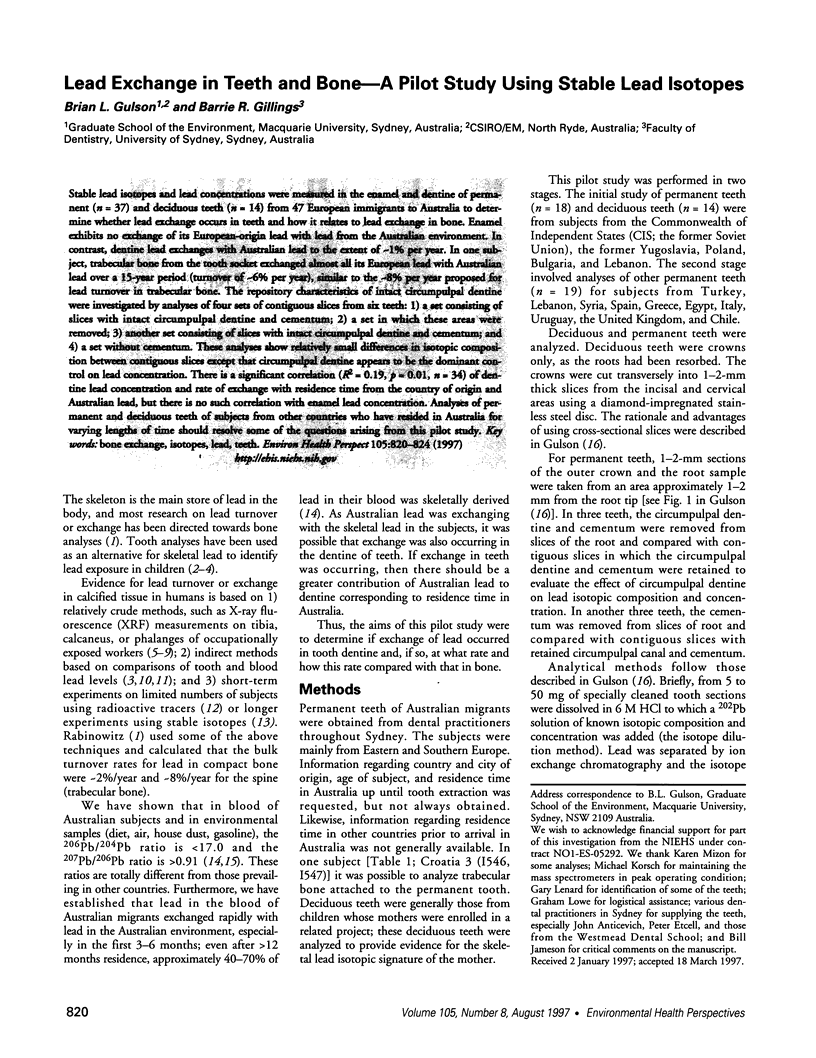
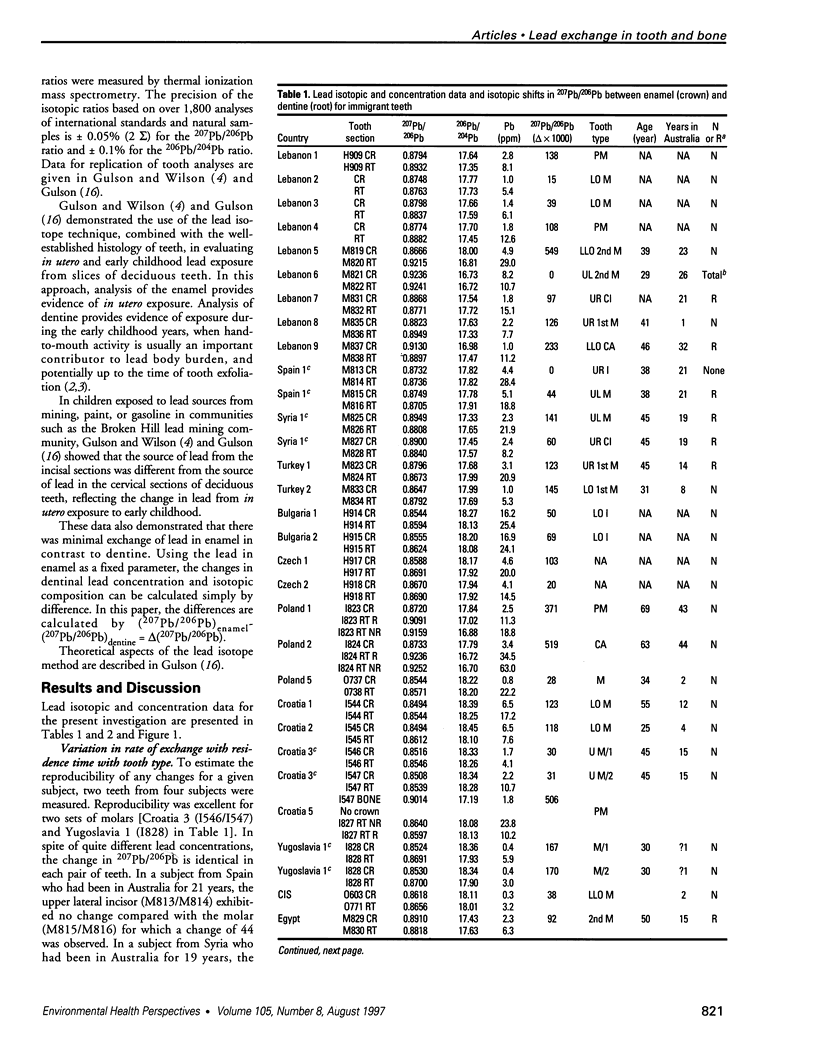
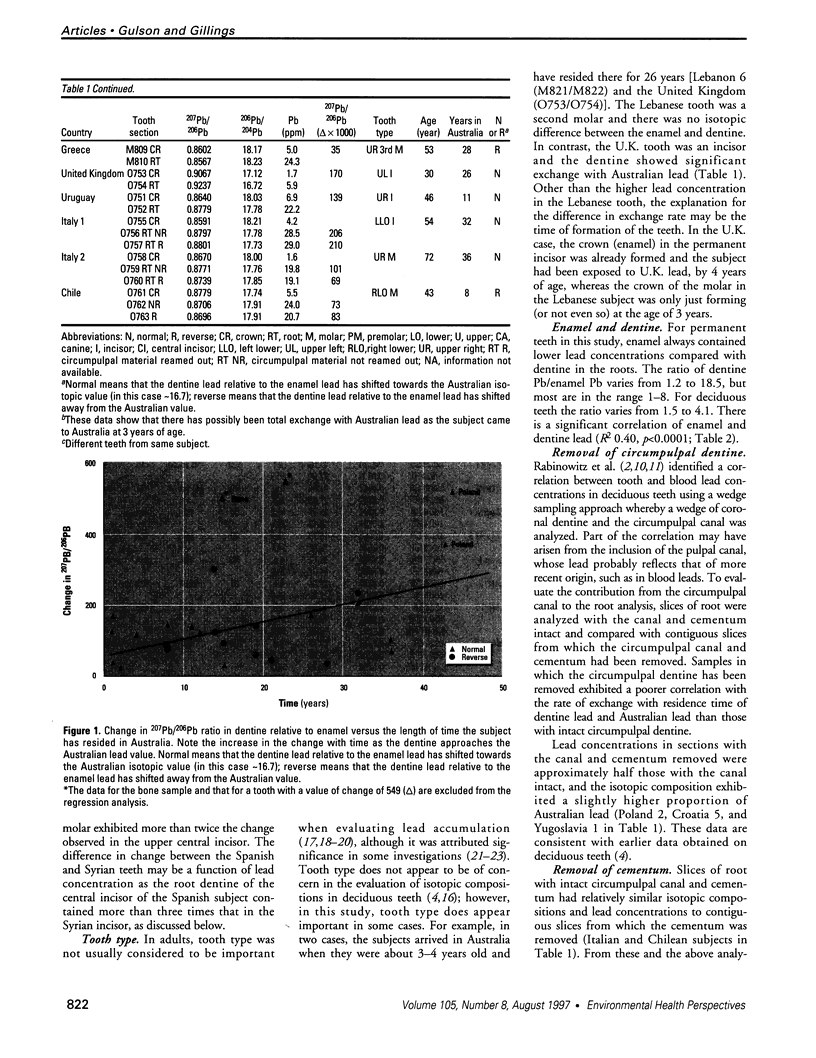
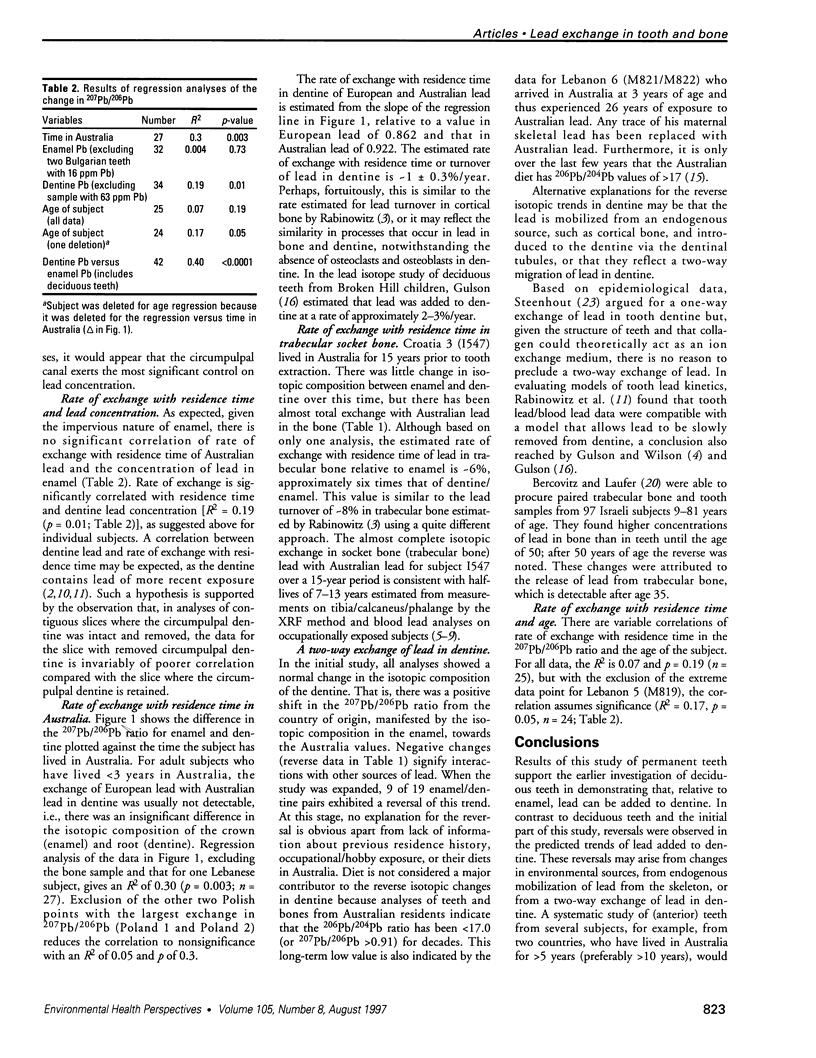
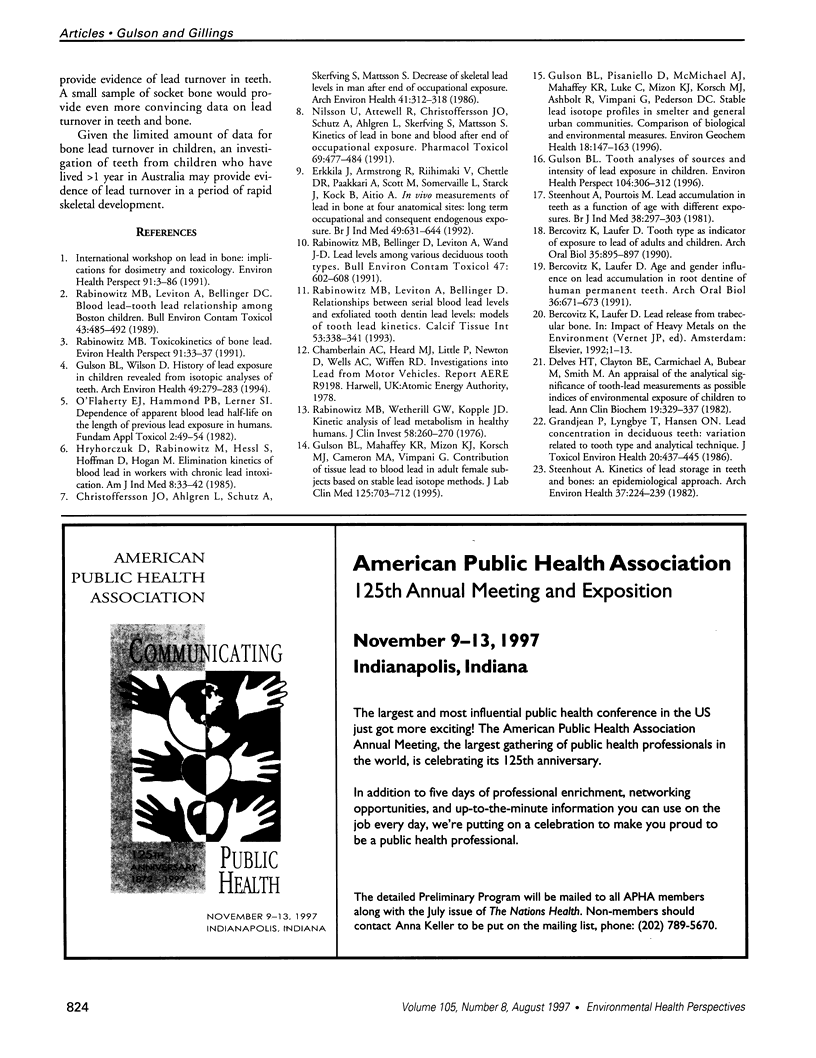
Images in this article
Selected References
These references are in PubMed. This may not be the complete list of references from this article.
- Bercovitz K., Laufer D. Age and gender influence on lead accumulation in root dentine of human permanent teeth. Arch Oral Biol. 1991;36(9):671–673. doi: 10.1016/0003-9969(91)90020-u. [DOI] [PubMed] [Google Scholar]
- Bercovitz K., Laufer D. Tooth type as indicator of exposure to lead of adults and children. Arch Oral Biol. 1990;35(11):895–897. doi: 10.1016/0003-9969(90)90069-m. [DOI] [PubMed] [Google Scholar]
- Christoffersson J. O., Ahlgren L., Schütz A., Skerfving S., Mattsson S. Decrease of skeletal lead levels in man after end of occupational exposure. Arch Environ Health. 1986 Sep-Oct;41(5):312–318. doi: 10.1080/00039896.1986.9936703. [DOI] [PubMed] [Google Scholar]
- Delves H. T., Clayton B. E., Carmichael A., Bubear M., Smith M. An appraisal of the analytical significance of tooth-lead measurements as possible indices of environmental exposure of children to lead. Ann Clin Biochem. 1982 Sep;19(Pt 5):329–337. doi: 10.1177/000456328201900502. [DOI] [PubMed] [Google Scholar]
- Erkkilä J., Armstrong R., Riihimäki V., Chettle D. R., Paakkari A., Scott M., Somervaille L., Starck J., Kock B., Aitio A. In vivo measurements of lead in bone at four anatomical sites: long term occupational and consequent endogenous exposure. Br J Ind Med. 1992 Sep;49(9):631–644. doi: 10.1136/oem.49.9.631. [DOI] [PMC free article] [PubMed] [Google Scholar]
- Grandjean P., Lyngbye T., Hansen O. N. Lead concentration in deciduous teeth: variation related to tooth type and analytical technique. J Toxicol Environ Health. 1986;19(3):437–444. doi: 10.1080/15287398609530941. [DOI] [PubMed] [Google Scholar]
- Gulson B. L., Mahaffey K. R., Mizon K. J., Korsch M. J., Cameron M. A., Vimpani G. Contribution of tissue lead to blood lead in adult female subjects based on stable lead isotope methods. J Lab Clin Med. 1995 Jun;125(6):703–712. [PubMed] [Google Scholar]
- Gulson B. L. Tooth analyses of sources and intensity of lead exposure in children. Environ Health Perspect. 1996 Mar;104(3):306–312. doi: 10.1289/ehp.96104306. [DOI] [PMC free article] [PubMed] [Google Scholar]
- Gulson B., Wilson D. History of lead exposure in children revealed from isotopic analyses of teeth. Arch Environ Health. 1994 Jul-Aug;49(4):279–283. doi: 10.1080/00039896.1994.9937480. [DOI] [PubMed] [Google Scholar]
- Hryhorczuk D. O., Rabinowitz M. B., Hessl S. M., Hoffman D., Hogan M. M., Mallin K., Finch H., Orris P., Berman E. Elimination kinetics of blood lead in workers with chronic lead intoxication. Am J Ind Med. 1985;8(1):33–42. doi: 10.1002/ajim.4700080105. [DOI] [PubMed] [Google Scholar]
- Nilsson U., Attewell R., Christoffersson J. O., Schütz A., Ahlgren L., Skerfving S., Mattsson S. Kinetics of lead in bone and blood after end of occupational exposure. Pharmacol Toxicol. 1991 Jun;68(6):477–484. doi: 10.1111/j.1600-0773.1991.tb01273.x. [DOI] [PubMed] [Google Scholar]
- O'Flaherty E. J., Hammond P. B., Lerner S. I. Dependence of apparent blood lead half-life on the length of previous lead exposure in humans. Fundam Appl Toxicol. 1982 Jan-Feb;2(1):49–54. doi: 10.1016/s0272-0590(82)80064-x. [DOI] [PubMed] [Google Scholar]
- Rabinowitz M. B., Bellinger D., Leviton A., Wang J. D. Lead levels among various deciduous tooth types. Bull Environ Contam Toxicol. 1991 Oct;47(4):602–608. doi: 10.1007/BF01700952. [DOI] [PubMed] [Google Scholar]
- Rabinowitz M. B., Leviton A., Bellinger D. C. Blood lead--tooth lead relationship among Boston children. Bull Environ Contam Toxicol. 1989 Oct;43(4):485–492. doi: 10.1007/BF01701924. [DOI] [PubMed] [Google Scholar]
- Rabinowitz M. B., Leviton A., Bellinger D. Relationships between serial blood lead levels and exfoliated tooth dentin lead levels: models of tooth lead kinetics. Calcif Tissue Int. 1993 Nov;53(5):338–341. doi: 10.1007/BF01351840. [DOI] [PubMed] [Google Scholar]
- Rabinowitz M. B. Toxicokinetics of bone lead. Environ Health Perspect. 1991 Feb;91:33–37. doi: 10.1289/ehp.919133. [DOI] [PMC free article] [PubMed] [Google Scholar]
- Rabinowitz M. B., Wetherill G. W., Kopple J. D. Kinetic analysis of lead metabolism in healthy humans. J Clin Invest. 1976 Aug;58(2):260–270. doi: 10.1172/JCI108467. [DOI] [PMC free article] [PubMed] [Google Scholar]
- Steenhout A. Kinetics of lead storage in teeth and bones: an epidemiologic approach. Arch Environ Health. 1982 Jul-Aug;37(4):224–231. doi: 10.1080/00039896.1982.10667569. [DOI] [PubMed] [Google Scholar]
- Steenhout A., Pourtois M. Lead accumulation in teeth as a function of age with different exposures. Br J Ind Med. 1981 Aug;38(3):297–303. doi: 10.1136/oem.38.3.297. [DOI] [PMC free article] [PubMed] [Google Scholar]



